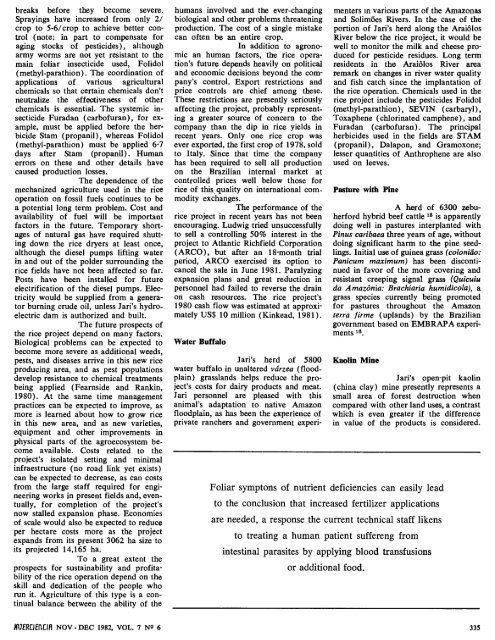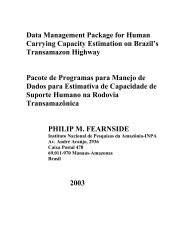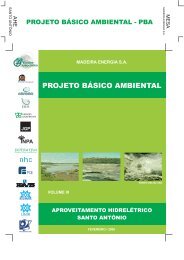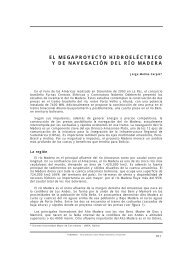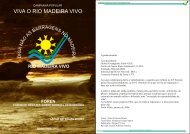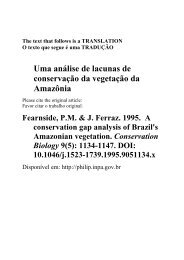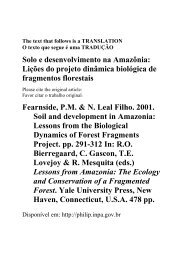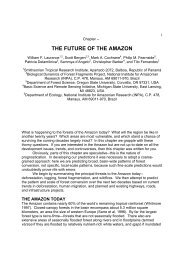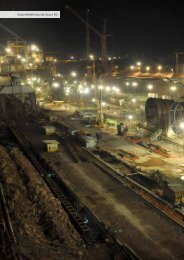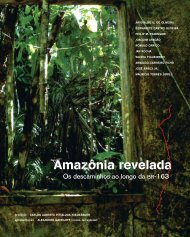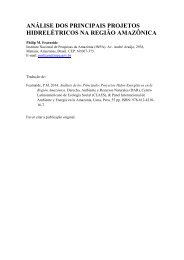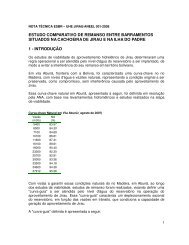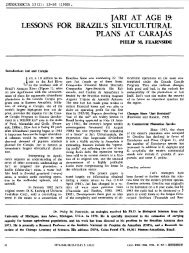have a synergistic effect with iron toxicitycontributing to reduced absorptionof nutrients by <strong>the</strong> rice plant. Theplants respond to roots being puncturedby stink bugs by replacing <strong>the</strong>m withadditional roots. Foliar symptoms ofnutrient deficiencies can easily lead to<strong>the</strong> conclusion that increased fertilizerapplications are needed, a response <strong>the</strong>current technical staff likens to treatinga human patient suffering from intestinalparasites by applying blood transfusionsor additional food. Increased attentionto insect problems may reduce <strong>the</strong> costand increase <strong>the</strong> effectiveness of futureresponses to <strong>the</strong>se symptoms.Nematodes are an additionalproblem found by <strong>the</strong> currentteam of technical staff, which beganwork at <strong>the</strong> IRI Research Institute stationassociated with <strong>the</strong> rice project in <strong>the</strong>latter part of 1980. The problem's severityand <strong>the</strong> possibility of control arestill under investigation. Aphids (Aphididae)in <strong>the</strong> rice roots and mites (Acari) ,are two additional problems discoveredby <strong>the</strong> present research team.Rice diseases presentinclude rice blast (Piricularia oryzae), towhich <strong>the</strong> IR-22 variety now being phasedout is very susceptible (but which didnot inflict economically significant lossesduring <strong>the</strong> time that IR-22 served as Jari'smainstay). Leaf scald (Rhynchoporiumoryzae) has been <strong>the</strong> most damagingdisease for both IR-22 and J-226. J-226seed is being propagated as a promisingreplacement for both IR-22 and <strong>the</strong> J-229progressively supplanting IR-22 since1979. Brown leaf spot (Helminthosporiumoryzae) is also present, as well as alittle false smut (Ustilagenoides virens).Although diseases represent a constantworry to rice growers, J ari's rice hasnot suffered unduly from <strong>the</strong>m sofar. "Hoja blanca" virus, a majorproblem in Venezuela, has still notarrived at J ari. The most effective responseto disease problems is generallya switch to more resistant varieties, chemicaltreatments representing only a temporarymeasure. The greatest problemis ability to produce sufficient seed fastenough to effect a variety change whenand outbreak occurs (given that a resistantvariety is available in <strong>the</strong> pool ofstrains undergoing testing at <strong>the</strong> site).Sufficient seed was not available to complete<strong>the</strong> switch from IR-22 to J-229two years after <strong>the</strong> change began, andJ-229 is now already slated for replacementas soon as enough J-226 seed isavailable.Weeds are a continualworry in <strong>the</strong> Jari rice project, as in irrigatedrice everywhere. Barnyard grass(Echinochloa crusgalli) is present at low334levels throughout <strong>the</strong> rice area, althoughit has not exploded to inflict <strong>the</strong> severelosses it is capable of causing. Wild redrice (Oryza rufipogon) is now present atJari's Sao Raimundo rice project in lowlevels. Wild red rice is a major problemin many parts of <strong>the</strong> world because it isdifficult to distinguish from domesticrice (0. sativa), many seeds fall from <strong>the</strong>panicles before harvest allowing it to reseedin <strong>the</strong> paddies, and any grainsharvested shatter when milled, thuslowering product quality. The most effectiveway to control <strong>the</strong>se and mosto<strong>the</strong>r weeds is to pre-flood <strong>the</strong> fields togerminate <strong>the</strong> weeds, followed by drain.ing and multiple herbicide sprayings priorto flooding and planting. These timeconsumingand expensive procedures areso far only used for <strong>the</strong> seed productionbeds. In production fields weed control ispresently limited to one spraying beforeplanting (ei<strong>the</strong>r Dalapon of Gramoxone),followed by spraying with Starn (Propanil)when <strong>the</strong> rice is growing. Onehigh spots. Ano<strong>the</strong>r engineering changebegan in 1980: construction of an additionalcanal through <strong>the</strong> middle of eachlarge field, allowing independent fillingof each of <strong>the</strong> paddies into which <strong>the</strong>large fields are divided. The <strong>new</strong> canalsreduce <strong>the</strong> time required to fill a paddyfrom eight days to 36 hours. The <strong>new</strong>canals in presently existing rice productionfields will be complete by <strong>the</strong> endof 1983, if <strong>the</strong> construction schedule isfollowed.Beginning in 1980, ricecrops are planted on a rolling basisra<strong>the</strong>r than in two distinctly separateand more synchronized cropping periods.The number of crops obtained from anygiven paddy is still limited to two, as<strong>the</strong> remaining time is insufficient for afull third crop. In <strong>the</strong> future <strong>the</strong> 1-226variety may allow about 30% of a fullcrop's yield to be harvested from resproutsas a stubble crop during this timeslot, but this possibility is still, in <strong>the</strong>testing phase. Rotation crops o<strong>the</strong>r thanPolitical and bureaucratic decisions affecting <strong>the</strong> sylviculturaloperation may have at least as much impact on its ultimate sustainabilityas <strong>the</strong> many biological and agronomic threats to continued production.marantaceous weed (Thalia geniculata)has not been sucessfully controlled with<strong>the</strong>se procedures, but <strong>the</strong> problem hasnot grown to economically damagingproportions. O<strong>the</strong>r weeds include an unidentifiedPhaseolus species, and ano<strong>the</strong>rwild rice species (Oryza alta). Two majorgraminaceous weeds in Surinam ( Barett,nd. (1975) ) not yet arrived at Jari(R. Cheaney, personal communication,1980) are Leptochloa scabea and Jschaemumrugosum. The latter is considered<strong>the</strong> "most dangerous grass inSurinam" (Doeven and Peorink, 1955,cited by Grist, 197 5: 280) .A number of remediesare underway for <strong>the</strong> various agronomicproblems and <strong>the</strong> decline in rice yieldsmay not continue if <strong>the</strong>se are effective.A major effort is improvement of <strong>the</strong>physical structure of fields and dikes toallow more finely tuned and rapid responsesto water management problems.Fields are being regraded at considerableexpense. Slight depressions and "highspots" in <strong>the</strong> present fields have been aconstant headache hampering uniformflooding or drying of fields to controlinsects, weeds or o<strong>the</strong>r problems. Armyworms, for example, preferentially attackrice are also being tested, including sweetpotatoes (Ipomoea batatas), maize (Zeamays), sunflowers (Helianthus annus),sorghum (Sorghum vulgare), cow-peas(Vigna sinensis), winged beans (Psophocarpustetragonolobus), soya beans (Glycinemax), peanuts (Arachis hypogaea),and an unidentified local legume greenmanure crop. Taro (Colocasia esculenta)is being tested as a potential alcoholcrop, and a native papyrus (Cyperusspp.) may be tested as a potential pulpsource. Rotation crops could help reducepest problems, as well as fertilizer costsin <strong>the</strong> case of green manure crops.The search continuesfor rice varieties more tolerant of suboptimalmanagement, and for varietieswith greater tolerance for iron toxicity.Variety screening continues, as well asresearch on possible rice managementchanges. Research on annual crops onterra firme (unflooded uplands) at SaoRaimundo was discontinued in 1979.Better insect populationmonitoring methods have been institutedin <strong>the</strong> irrigated rice fields (sweep nettransects ra<strong>the</strong>r than 1 m2 quadrats),and spraying programs have been adaptedto try and control more insect out-NOV- DEC 1982, VOL. 7 NQ 6 IIVERlJENJR
eaks before <strong>the</strong>y become severe.Sprayings have increased from only 2/crop to 5-61 crop to achieve better control(note: in part to compensate foraging stocks of pesticides), althougharmy worms are not yet resistant to <strong>the</strong>main foliar insecticide used, Folidol(methyl-parathion). The coordination ofapplications of various agriculturalchemicals so that certain chemicals don'tneutralize <strong>the</strong> effectiveness of o<strong>the</strong>rchemicals is essential. The systemic insecticideFuradan ( carbofuran), for example,must be applied before <strong>the</strong> herbicideStarn (propanil), whereas Folidol(methyl-parathion) must be applied 6-7days after Starn (propanil). Humanerrors on <strong>the</strong>se and o<strong>the</strong>r details havecaused production losses.The dependence of <strong>the</strong>mechanized agriculture used in <strong>the</strong> riceoperation on fossil fuels continues to bea potential long term problem. Cost andavailability of fuel will be importantfactors in <strong>the</strong> future. Temporary shortagesof natural gas have required shuttingdown <strong>the</strong> rice dryers at least once,although <strong>the</strong> diesel pumps lifting waterin and out of <strong>the</strong> polder surrounding <strong>the</strong>rice fields have not been affected so far.Posts have been installed for futureelectrification of <strong>the</strong> diesel pumps. Electricitywould be supplied from a generatorburning crude oil, unless Jari's hydroelectricdam is authorized and built.The future prospects of<strong>the</strong> rice project depend on many factors.Biological problems can be expected tobecome more severe as additional weeds,pests, and diseases arrive in this <strong>new</strong> riceproducing area, and as pest populationsdevelop resistance to chemical treatmentsbeing applied ( <strong>Fearnside</strong> and Rankin,1980). At <strong>the</strong> same time managementpractices can be expected to improve, asmore is learned about how to grow ricein this <strong>new</strong> area, and as <strong>new</strong> varieties,equipment and o<strong>the</strong>r improvements inphysical parts of <strong>the</strong> agroecosystem becomeavailable. Costs related to <strong>the</strong>project's isolated setting and minimalinfraestructure (no road link yet exists)can be expected to decrease, as can costsfrom <strong>the</strong> large staff required for engineeringworks in present fields and, eventually,for completion of <strong>the</strong> project'snow stalled expansion phase. Economiesof scale would also be expected to reduceper hectare costs more as <strong>the</strong> projectexpands from its present 3062 ha size toits projected 14,165 ha.To a great extent <strong>the</strong>prospects for sustainability and profitabilityof <strong>the</strong> rice operation depend on <strong>the</strong>skill and dedication of <strong>the</strong> people whorun it. Agriculture of this type is a continualbalance between <strong>the</strong> ability of <strong>the</strong>humans involved and <strong>the</strong> ever-changingbiological and o<strong>the</strong>r problems threateningproduction. The cost of a single mistakecan often be an entire crop.In addition to agronomican human factors, <strong>the</strong> rice operation'sfuture depends heavily on politicaland economic decisions beyond <strong>the</strong> company'scontrol. Export restrictions andprice controls are chief among <strong>the</strong>se.These restrictions are presently seriouslyaffecting <strong>the</strong> project, probably representinga greater source of concern to <strong>the</strong>company than <strong>the</strong> dip in rice yields inrecent years. Only one rice crop wasever exported, <strong>the</strong> first crop of 1978, soldto Italy. Since that time <strong>the</strong> companyhas been required to sell all productionon <strong>the</strong> Brazilian internal market atcontrolled prices well below those forrice of thi~, quality on international commodityexchanges.The performance of <strong>the</strong>rice project in recent years has not beenencouraging. Ludwig tried unsuccessfullyto sell a controlling 50% interest in <strong>the</strong>project to Atlantic Richfield Corporation(ARCO), but after an 18-month trialperiod, ARCO exercised its option tocancel <strong>the</strong> sale in June 1981. Paralyzingexpansion plans and great reduction inpersonnel had failed to reverse <strong>the</strong> drainon cash resources. The rice project's1980 cash flow was estimated at approximatelyUS$ 10 million (Kinkead, 1981).Water BuffaloJari's herd of 5800water buffalo in unaltered wirzea (floodplain)grasslands helps reduce <strong>the</strong> project'scosts for dairy products and meat.J ari personnel are pleased with thisanimal's adaptation to native Amazonfloodplain, as has been <strong>the</strong> experience ofprivate ranchers and government experimentersm various parts of <strong>the</strong> Amazonasand SolimOes Rivers. In <strong>the</strong> case of <strong>the</strong>portion of Jari's herd along <strong>the</strong> AraiolosRiver below <strong>the</strong> rice project, it would bewell to monitor <strong>the</strong> milk and cheese producedfor pesticide residues. Long termresidents in <strong>the</strong> Araiolos River arearemark on changes in river water qualityand fish catch since <strong>the</strong> implantation of<strong>the</strong> rice operation. Chemicals used in <strong>the</strong>rice project include <strong>the</strong> pesticides Folidol(methyl-parathion), SEVIN (carbaryl),Toxaphene (chlorinated camphene), andFuradan ( carbofuran). The principalherbicides used in <strong>the</strong> fields are ST AM(prop a nil), Dalapon, and Gramoxone;lesser quantities of Anthrophene are alsoused on leeves.Pasture with PineA herd of 6300 zebuherfordhybrid beef cattle 111 is apparentlydoing well in pastures interplanted withPinus caribaea three years of age, withoutdoing significant harm to <strong>the</strong> pine seedlings.Initial use of guinea grass ( coloniiio:Panicum maximum) has been discontinuedin favor of <strong>the</strong> more covering andresistant creeping signal grass ( Quicuiuda Amazonia: Brachiaria humidicola), agrass species currently being promotedfor pastures throughout <strong>the</strong> Amazonterra firme (uplands) by <strong>the</strong> Braziliangovernment based on EMBRAP A experiments16 •Kaolin MineJari's open-pit kaolin(china clay) mine presently represents asmall area of forest destruction whencompared with o<strong>the</strong>r land uses, a contrastwhich is even greater if <strong>the</strong> differencein value of <strong>the</strong> products is considered.Foliar symptons of nutrient deficiencies can easily leadto <strong>the</strong> conclusion that increased fertilizer applicationsare needed, a response <strong>the</strong> current technical staff likensto treating a human patient suffereng fromintestinal parasites by applying blood transfusionsor additional food.IIUER[}Ef\[IR NOV- DEC 1982, VOL. 7 N9 6335


